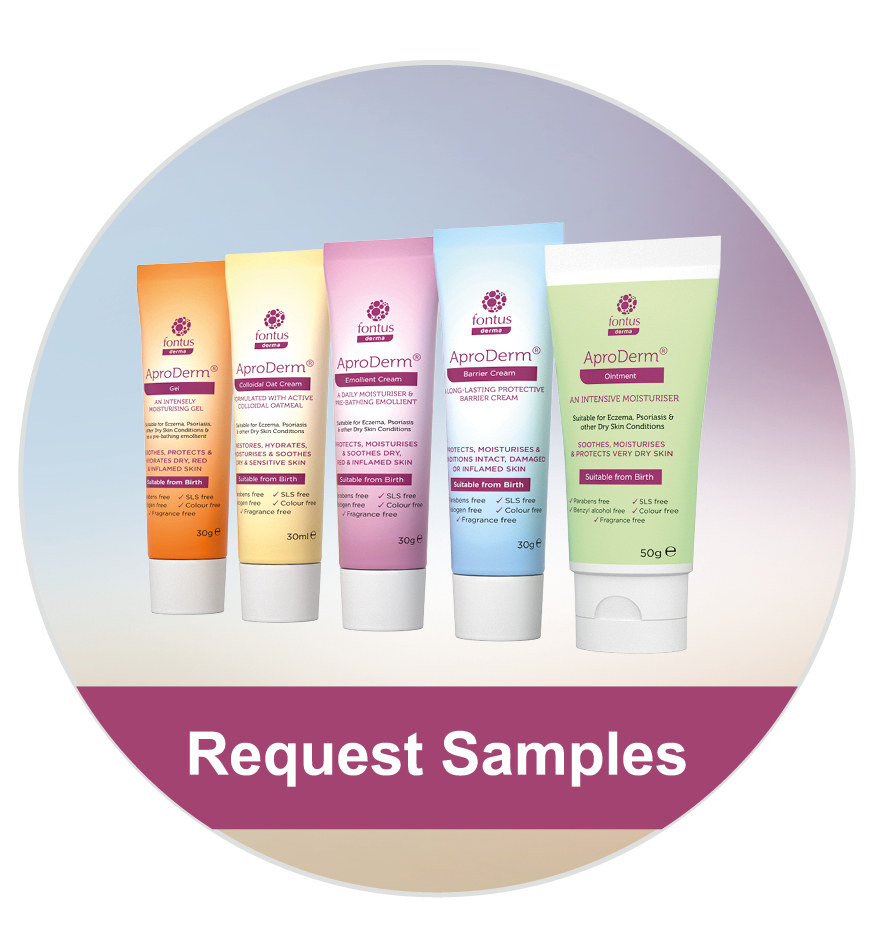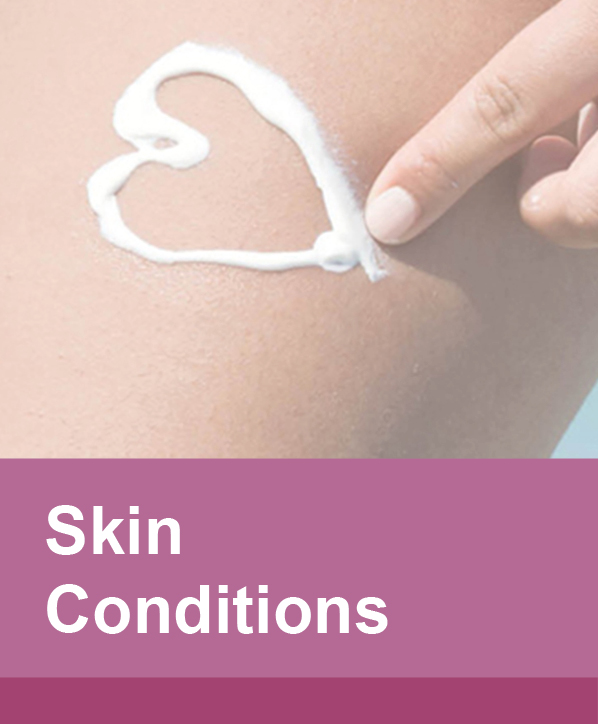AproDerm® Emollient Cream is a soap substitute and occlusive, leave-on emollient that is suitable from birth and soothes, moisturises and protects skin suffering from Eczema, Psoriasis and other Dry Skin Conditions. Formulated with 15% white soft paraffin and 6% liquid paraffin, AproDerm® Emollient Cream is Drug Tariff listed and so is readily available to prescribe as either a 50g tube or a 500g pump dispenser.

Developed with the patient in mind, AproDerm® Emollient Cream is:

- An effective soap substitute for daily use
- Suitable from Birth
- A cooling cream that absorbs easily into the skin
- Creates a protective layer on the skin
- Up to 29%1 more cost-effective than similar emollient creams
- Suitable for Vegans
- Not tested on animals
- Dermatologically tested
- AproDerm® Emollient Cream is free from SLS, parabens, chlorocresol, fragrances and colours, these excipients are recognised potential irritants and sensitisers, as listed by MIMS2, which can be found in many creams. They can aggravate already sensitive skin which is why such excipients are absent from AproDerm® Emollient Cream hence it can be considered that the risk of a reaction to a patient will be greatly reduced thus aiding compliance.
An irritant is a substance that causes inflammation to the body in a non-immune way and can affect anyone who comes into contact with sufficient amounts of it for long enough, however those with atopic eczema are more sensitive to irritants. The skin can react straight away (immediate response) or after a period of repeated exposure. Irritants remove moisture (by affecting Natural Moisturising Factor) and oils from the outer skin layer allowing pathogens, irritants and allergens to enter the skin causing inflammation and further damage.
A skin sensitiser is a chemical that will cause an allergic reaction when exposed to the skin and, unlike an irritant, it will only affect those who are allergic to it. The initial exposure will not cause a reaction but continued exposure can and once a person has been sensitised to a product, contact with even a small amount of it will cause a reaction. The two conditions allergic and irritant dermatitis may coexist.
Symptoms typically seen include skin which can be red, swollen, blistered, dry, thickened, intensely itchy and cracked depending on whether the reaction is acute or chronic.
For a list of potential sensitisers found in emollients click here
The table below compares AproDerm® Emollient Cream against similar emollient creams
| Product | Suitable from Birth |
SLS Free | Parabens Free | Chlorocresol Free | Fragrance Free | Colour Free | Pack Size | Price1 |
|---|---|---|---|---|---|---|---|---|
| AproDerm® Emollient Cream | 
|

|

|

|

|

|
500g | £4.95 |
| Epaderm® Cream |  |
 |
 |
 |
 |
 |
500g | £7.01 |
| Diprobase® Cream | On advice of HCP | 
|

|
 |

|

|
500g | £6.32 |
| E45® Cream |  |
 |
 |
 |
 |
 |
500g | £5.99 |
| Cetraben® Cream | < 1 year treat under medical supervision |
 |
 |
 |
 |
 |
500g | £5.99 |
| Zerobase® Cream | < 1 year treat under medical supervision |
 |
 |
 |
 |
 |
500g | £5.26 |
Table 1: Comparison of Aproderm® Emollient Cream with similar prescribed emollient products4
- An effective soap substitute for use in the bath or shower, for bathing babies and for daily hand washing
- Suitable from Birth
- A cooling cream that absorbs easily into the skin
- Suitable for daily use
- Creates a protective layer on the skin
- Up to 29%1 more cost-effective than similar emollient creams
- Suitable for Vegans
- Not tested on animals
- Dermatologically tested
- The 500g AproDerm® Emollient Cream uses airless pump dispenser technology – designed to decrease the risk of product contamination and reduce wastage
AproDerm® Emollient Cream:
- An effective soap substitute
- Suitable from Birth
- Soothes, moisturises and protects skin suffering from Eczema, Psoriasis & other Dry Skin Conditions
- Suitable for those sensitive to SLS, chlorocresol, fragrances and colours
- Suitable for those with parabens sensitisation
- For the symptomatic relief of dry, red, inflamed or damaged skin
- Protects raw areas of skin
The AproDerm® Emollient Cream Range:
| Product | Pack Size | PIP Code | Price1 |
|---|---|---|---|
| AproDerm® Emollient Cream | 50g | 402-1226 | £1.70 |
| AproDerm® Emollient Cream | 500g | 402-1218 | £4.95 |
Patient compliance is crucial to successful emollient therapy and studies have shown that educating patients (and parents or carers of children) about the causes of their condition and correct emollient application improves outcomes significantly. In addition to this, NICE Clinical Guideline 57 “Management of atopic eczema in children from birth up to the age of 12 years” also advises that they (patient and parent or carer) be educated by healthcare professionals on quantity and frequency of use of treatments, flare-ups and their management (using the stepped approach plan) and the recognition and treatment of infections.
Some key points to cover with your patient during consultation are:
- Information on eczema, psoriasis and other dry skin conditions. View or print Eczema, Psoriasis and other Dry Skin Conditions PDFs for patients.
- AproDerm® Emollient Cream should not be prescribed if the patient has a known allergy or sensitivity to any of the listed ingredients.
- As with all emollients, before applying AproDerm® Emollient Cream for the first time, patients should test it on a small area of skin and leave for 48 hours. If there is no reaction or irritation they can then apply all over the affected area. This limits any potential reaction to a small area.
- AproDerm® Emollient Cream should be applied regularly, liberally and frequently to the affected area, using gentle downward strokes, following the direction of hair growth. It is important to remind patients that they should not rub emollients into the skin as rubbing can cause further irritation and itching (by generating heat) and can also cause folliculitis (as a result of blocking the hair follicles and causing their inflammation).
- Frequency of application will be determined by severity of the condition and whether more than one emollient is being used. As a general guide it is recommended that AproDerm® Emollient Cream is applied as often as required as well as during and after bathing to help alleviate the drying effects of bathing and used as a daily soap substitute.
- Patients should also be reminded to continue applying AproDerm® Emollient Cream once their skin has improved to prevent the risk of flare-ups.
- Use during pregnancy or breastfeeding is unlikely to have any ill effects when the product is used as directed.
For further information on emollient application please visit our How To Apply page. Other useful information for your patients can be found in our printable Tips and Advice section.
AproDerm® Emollient Cream contains:
Active Ingredients: White Soft Paraffin 15%, Liquid Paraffin 6%.
Other Ingredients: Cetearyl Alcohol, Ceteareth-20, Aqua, Sodium Dihydrogen Phosphate Dihydrate, Phenoxyethanol, Ethylhexylglycerin.
Storage:
Store below 25°C. Do not refrigerate or freeze.
Please note: Emollients containing paraffin can be easily ignited with a naked flame. If the product comes into contact with dressings and clothes they can be more easily ignited with a naked flame. Remind patients that they should keep away from fire when using these types of emollients. For further information visit the National Patient Safety Agency website.
AproDerm® Emollient Cream is for external use only, if your patient accidentally swallows some of it they should seek medical advice immediately.
1 Dictionary of Medicines and Devices (Dm+D) February 2019 [Accessed on 13 February 2019] | 2 Mims.co.uk. (2017). Emollients, Potential Skin Sensitisers as Ingredients. [online] Available at: https://www.mims.co.uk/emollients-potential-skin-sensitisers-ingredients/dermatology/article/882437 | 3 Data on file [Accessed 8 Mar. 2018] | 4 Data on file







